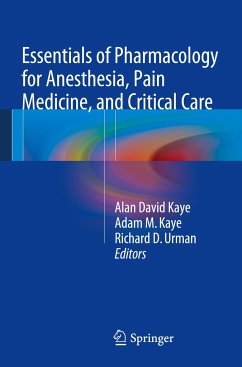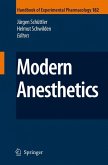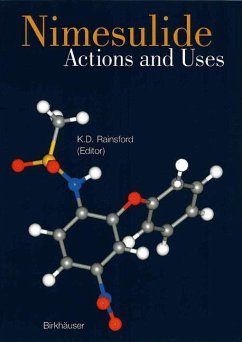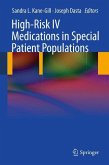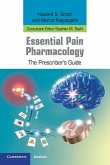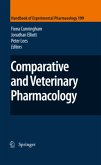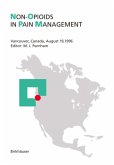Essentials of Pharmacology for Anesthesia, Pain Medicine, and Critical Care
Herausgegeben:Kaye, Alan David; Kaye, Adam M.; Urman, Richard D.
Essentials of Pharmacology for Anesthesia, Pain Medicine, and Critical Care
Herausgegeben:Kaye, Alan David; Kaye, Adam M.; Urman, Richard D.
- Broschiertes Buch
- Merkliste
- Auf die Merkliste
- Bewerten Bewerten
- Teilen
- Produkt teilen
- Produkterinnerung
- Produkterinnerung
In anesthesiology, pain medicine, and critical care, practitioners at all levels need help to stay current with the continually evolving drug knowledge-base and trainees need tools to prepare for in-training and board exams that increasingly test their knowledge of pharmacology. This practical book is aimed at both readerships. It features a unique and practical chapter on the United States Food and Drug Administration (FDA) "black box" warnings that describe what safety precautions should be taken with commonly used drugs. The editors and contributors are pharmacology experts representing a…mehr
Andere Kunden interessierten sich auch für
![Modern Anesthetics Modern Anesthetics]() Jürgen Schüttler / Helmut SchwildenModern Anesthetics446,99 €
Jürgen Schüttler / Helmut SchwildenModern Anesthetics446,99 €![Nimesulide - Actions and Uses Nimesulide - Actions and Uses]() Kim D. Rainsford (ed.)Nimesulide - Actions and Uses121,99 €
Kim D. Rainsford (ed.)Nimesulide - Actions and Uses121,99 €![High-Risk IV Medications in Special Patient Populations High-Risk IV Medications in Special Patient Populations]() High-Risk IV Medications in Special Patient Populations75,99 €
High-Risk IV Medications in Special Patient Populations75,99 €![Local Anesthetics Local Anesthetics]() Local Anesthetics81,99 €
Local Anesthetics81,99 €![Essential Pain Pharmacology Essential Pain Pharmacology]() Howard S. SmithEssential Pain Pharmacology160,99 €
Howard S. SmithEssential Pain Pharmacology160,99 €![Comparative and Veterinary Pharmacology Comparative and Veterinary Pharmacology]() Comparative and Veterinary Pharmacology223,99 €
Comparative and Veterinary Pharmacology223,99 €![Non-Opioids in Pain Management Non-Opioids in Pain Management]() ParnhamNon-Opioids in Pain Management41,99 €
ParnhamNon-Opioids in Pain Management41,99 €-
-
-
In anesthesiology, pain medicine, and critical care, practitioners at all levels need help to stay current with the continually evolving drug knowledge-base and trainees need tools to prepare for in-training and board exams that increasingly test their knowledge of pharmacology. This practical book is aimed at both readerships. It features a unique and practical chapter on the United States Food and Drug Administration (FDA) "black box" warnings that describe what safety precautions should be taken with commonly used drugs. The editors and contributors are pharmacology experts representing a cross-section of clinical specialties and institutions in the United States and include pharmacologists, pharmacists, as well as physicians.
Produktdetails
- Produktdetails
- Verlag: Springer / Springer New York / Springer, Berlin
- 2015
- Seitenzahl: 928
- Erscheinungstermin: 21. November 2014
- Englisch
- Abmessung: 235mm x 155mm x 47mm
- Gewicht: 1470g
- ISBN-13: 9781461489474
- ISBN-10: 1461489474
- Artikelnr.: 39194918
- Herstellerkennzeichnung Die Herstellerinformationen sind derzeit nicht verfügbar.
- Verlag: Springer / Springer New York / Springer, Berlin
- 2015
- Seitenzahl: 928
- Erscheinungstermin: 21. November 2014
- Englisch
- Abmessung: 235mm x 155mm x 47mm
- Gewicht: 1470g
- ISBN-13: 9781461489474
- ISBN-10: 1461489474
- Artikelnr.: 39194918
- Herstellerkennzeichnung Die Herstellerinformationen sind derzeit nicht verfügbar.
Alan David Kaye Departments of Anesthesiology and Pharmacology, LSU Health Sciences Center, New Orleans, LA, USA; LSU Interim Hospital and Ochsner Kenner Hospital, New Orleans, LA, USA Adam M. Kaye Department of Pharmacy Practice, Thomas J. Long School of Pharmacy and Health Sciences, University of the Pacific Stockton, CA, USA Richard D. Urman Department of Anesthesia, Harvard Medical School; Hospital Procedural Sedation Management and Safety, Center for Perioperative Management and Medical Informatics, Brigham and Women's Hospital, Boston, MA, USA
Part I. Basic Pharmacologic Principles.- 1. Pharmacokinetics and Pharmacodynamics of Anesthetics.- 2. A Review of Mechanisms of Inhalational Anesthetic Agents.- 3. Pharmacokinetics, pharmacodynamics and physical properties of Inhalational agents.- 4. Principles of Total Intravenous Anesthesia.- 5. Perioperative Considerations in Pharmacology.- Part II. Drug Classes.- 6. Anesthetic Induction Agents.- 7. Analgesics: Opiate agonists, mixed agonist/antagonists and antagonists for acute pain management.- 8. Analgesics: Opioids for chronic pain management and surgical considerations.- 9. Nonopioid Analgesic and Adjunct Drugs.- 10. Benzodiazepines and muscle relaxants.- 11. Pharmacology of Local Anesthetics.- 12. Neuromuscular Blockers.- 13. Reversal agents.- 14. Drugs acting on the autonomic nervous system.- 15. Antihypertensives, diuretics and antidysrhythmics.- 16. Peripheral vasodilators.- 17. Nitric oxide and Pulmonary Vasodilators.- 18. Asthma and COPD agents.- 19. Hormones, Part 1: Thyroid and Corticosteroid Hormones.- 20. Hormones, Part 2: Insulin and Other glucose controlling Medications.- 21. Antacids, Gastrointestinal Prokinetics, And Proton Pump Inhibitors.- 22. Histamine modulators.- 23. Central Nervous System Stimulants.- 24. Anticoagulant drugs.- 25. Hemostatic Agents.- 26. BLOOD, BLOOD PRODUCTS, AND SUBSTITUTES.- 27. Antipyretics: Acetaminophen, Arachidonic Acid Agents, Cox1 And Cox2 Inhibitors.- 28. Antiemetic Agents.- 29. Antiepileptics agents.- 30. Neuropharmacologic agents for neurologic conditions.- 31. Chemotherapeutic Agents.- 32. Antimicrobial Agents.- 33. Herbals medications and vitamin supplements.- 34. Minerals and electrolytes.- 35. Disinfection agents and antiseptics.- 36. Psychopharmacologic agents and psychiatric drug considerations.- 37. Cocaine, Methamphetamine, MDMA and Heroin.- Part III. Clinical Subspecialties.- 38. Cardiac surgery.- 39. The Intensive Care Unit.- 40. Enteral and parenteral nutrition.- 41. Obstetrics.- 42. Pediatrics.- 43. Neurologic Surgery.- 44. Liver disease and liver transplantation.- Part IV. Special Topics.- 45. Black Box FDA warnings and legal implications.- 46. Drug-Induced QT Prolongation.- 47. Drugs and Cancer Propagation.- 48. Lipid Lowering Agents.- 49. Serotonin Syndrome.- Part V. New Vistas in Pharmacology.- 50. Novel Psychoactive Substances: synthetic cathinones and cannabinoid receptor agonists.- 51. New Vistas in Anesthetics, IV Induction Agents.- 52. New Vistas In Neuromuscular Blockers.- 53. Patient-Controlled Analgesia: The Importance of Effector Site Pharmacokinetics.- 54. Understanding anesthesia-induced memory loss.- 55. Novel Targets of Current Analgesic Drug Development.
Part I. Basic Pharmacologic Principles.- 1. Pharmacokinetics and Pharmacodynamics of Anesthetics.- 2. A Review of Mechanisms of Inhalational Anesthetic Agents.- 3. Pharmacokinetics, pharmacodynamics and physical properties of Inhalational agents.- 4. Principles of Total Intravenous Anesthesia.- 5. Perioperative Considerations in Pharmacology.- Part II. Drug Classes.- 6. Anesthetic Induction Agents.- 7. Analgesics: Opiate agonists, mixed agonist/antagonists and antagonists for acute pain management.- 8. Analgesics: Opioids for chronic pain management and surgical considerations.- 9. Nonopioid Analgesic and Adjunct Drugs.- 10. Benzodiazepines and muscle relaxants.- 11. Pharmacology of Local Anesthetics.- 12. Neuromuscular Blockers.- 13. Reversal agents.- 14. Drugs acting on the autonomic nervous system.- 15. Antihypertensives, diuretics and antidysrhythmics.- 16. Peripheral vasodilators.- 17. Nitric oxide and Pulmonary Vasodilators.- 18. Asthma and COPD agents.- 19. Hormones, Part 1: Thyroid and Corticosteroid Hormones.- 20. Hormones, Part 2: Insulin and Other glucose controlling Medications.- 21. Antacids, Gastrointestinal Prokinetics, And Proton Pump Inhibitors.- 22. Histamine modulators.- 23. Central Nervous System Stimulants.- 24. Anticoagulant drugs.- 25. Hemostatic Agents.- 26. BLOOD, BLOOD PRODUCTS, AND SUBSTITUTES.- 27. Antipyretics: Acetaminophen, Arachidonic Acid Agents, Cox1 And Cox2 Inhibitors.- 28. Antiemetic Agents.- 29. Antiepileptics agents.- 30. Neuropharmacologic agents for neurologic conditions.- 31. Chemotherapeutic Agents.- 32. Antimicrobial Agents.- 33. Herbals medications and vitamin supplements.- 34. Minerals and electrolytes.- 35. Disinfection agents and antiseptics.- 36. Psychopharmacologic agents and psychiatric drug considerations.- 37. Cocaine, Methamphetamine, MDMA and Heroin.- Part III. Clinical Subspecialties.- 38. Cardiac surgery.- 39. The Intensive Care Unit.- 40. Enteral and parenteral nutrition.- 41. Obstetrics.- 42. Pediatrics.- 43. Neurologic Surgery.- 44. Liver disease and liver transplantation.- Part IV. Special Topics.- 45. Black Box FDA warnings and legal implications.- 46. Drug-Induced QT Prolongation.- 47. Drugs and Cancer Propagation.- 48. Lipid Lowering Agents.- 49. Serotonin Syndrome.- Part V. New Vistas in Pharmacology.- 50. Novel Psychoactive Substances: synthetic cathinones and cannabinoid receptor agonists.- 51. New Vistas in Anesthetics, IV Induction Agents.- 52. New Vistas In Neuromuscular Blockers.- 53. Patient-Controlled Analgesia: The Importance of Effector Site Pharmacokinetics.- 54. Understanding anesthesia-induced memory loss.- 55. Novel Targets of Current Analgesic Drug Development.

